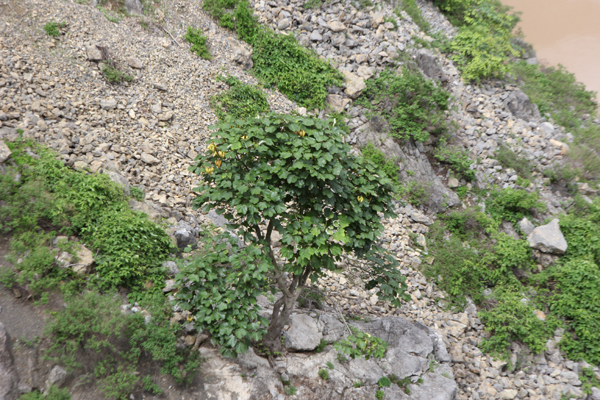Firmiana major, rediscovered after disappearing 20 years
Firmiana major,which was listed as extinct in the wild for almost 20 years, recently has been found in Jinsha River Basin of Yunnan Province.
Firmiana major is a species of flowering plant in the Sterculiaceae family, among which many species are listed as the national key protected plants, such as F. hainanensis and F. hainanensis.“The only remaining trees are those which have been planted around temples and villages. Wild populations were once believed to have existed in central and western Yunnan.” Firmiana major is described in IUCN Red List of Threatened Speices.
“since Firmiana major was listed on the IUCN Red List in 1998, we meanwhile deleted it in the List of National Key Protected Wild Plants in 1999 for extinction in the wild. But surprisingly, small populations, more than 200, were found in Panzhihua Cycad National Nature Reserve, Sichuan Province, and some conservation actions were launched immediately.” Yang Jing, from Kunming Institute of Botany (KIB), Chinese Academy of Sciences, who together with her collegues found Firmiana major in the wild.
As a member of Prof. Sun Weibang’s research team, Yangjing, with her colleagues, was in the remote mountains of Northwestern Yunnan Province for the field work.
“Firmiana major is not our targeted species for this time, we are not sure if it is still exist in the wild.” Yang said.
They started the investigation in Ninglang County for another rare plant. Along the rock wall of Jinsha River, they climbed to a cliff.
“we saw many ambors up the rock, not very tall, but with many branches, hanging with green-yellow fruits. They look like bananas, and five of them gathered like a claw in one branch. We judged from the shape of the leaves that they may be in the Sterculiaceae family.” Yang recalled.
After the identification of Prof. Wu Zhikun, the researcher from Lijiang Alpine Botanical Garden, KIB, the plant was identified initially to be Firmiana major.
It is said by the villagers around that they were fond of collecting the feeds for eating when the Firmiana major were with a great number, however, they could hardly see them recent years.
The researchers speculate that ingestion, overgrazing of pastures, land reclamation and climate change may become the major threats for its disappearing. “The two populations we discovered are still risk without any in situ conservation method.” Yang said.
After seeds mature, the researchers in Germplasm Bank of Wild Species, the biggest in China, will reproduce them artificially, and cultivate in Kunming Botanical Garden with the experiment on its tolerance of cold and humidity. Besides, ex-situ conservation site should be chosen along Jinsha River and hot-dry valley region. Meanwhile, to expand the wild population of Firmiana major, more need to plant near the site discovering the wild populations.
This project was funded by CUBG on the Full-Coverage Conservation of Native Plants in China.



